Having recently completed a road trip through SA, VIC and NSW, I have come to two conclusions…
- there are still some workers out there installing less than first-rate solar power systems,
- you never take as many photos as you should.
In any case, I have a few pictures which should make more than a passing interest, even if it’s only the solar nerds who appreciate the finer details.
Some Installations Just Warm The Cockles Of Your Heart
Here’s a system in Hay, NSW, where it’s instantly apparent that the rulebook has been thrown out.
The end product is a sight to behold. This isn’t the crap install of someone who can’t be arsed or the ignorance of some drug-addled roofer who’s working completely outside their expertise. Someone has meticulously engineered this.
Look! It’s sign-written on the front of the building. Not only does that awning offer shade, electricity generation and weather protection, but there’s also a winch and wheels attached to make it serviceable. This is function brought to fruition. Art with purpose. Banksy, eat your heart out.
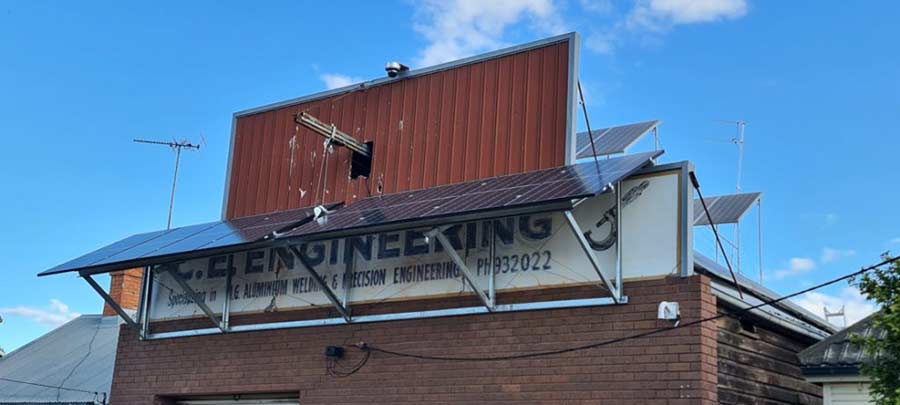
I’ve always been a fan of solar awnings.
And the solar panels, they’re everywhere. Fixed at all angles, in all manner of ways, someone has thought hard about how to catch more rays. Predating all the PV, there’s even a good old Solahart up the back there for simple bolt honest hot water.
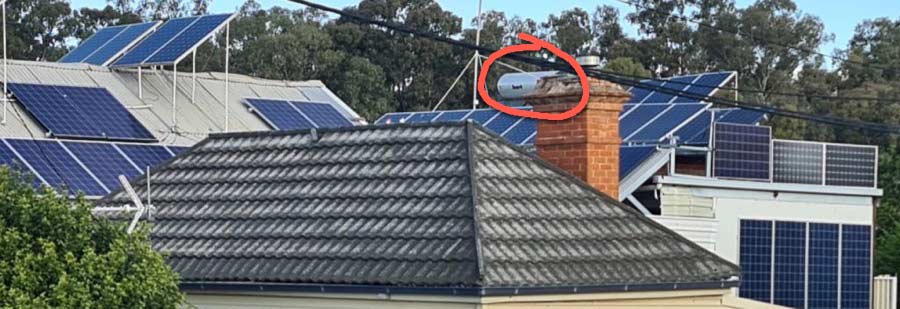
The hot water unit must be pre-2010
Walking out of the pub after a decidedly ordinary meal (does NSW even know a parmy has ham?) as the very last of the sun streaks the sky, you realise Hay has a “sunset lookout” for a reason. Those modules placed vertically on the western side aren’t just decorative, they are placed, just so, to gather the dying of the light.
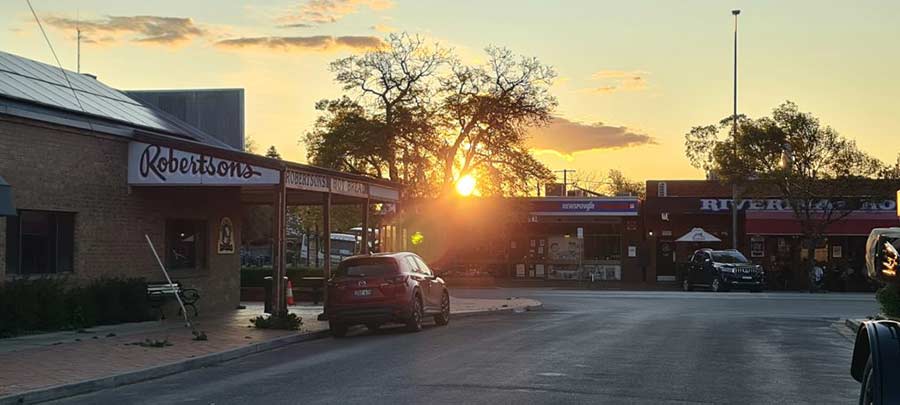
Sunset is a terrible time to head west from Hay.
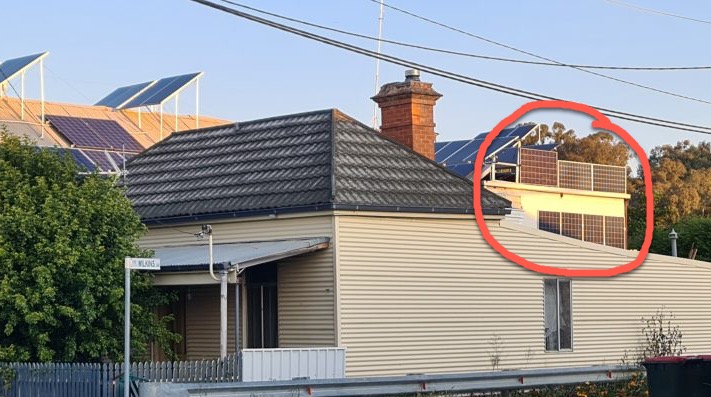
Vertical solar isn’t just for high latitudes.
And as an electrician, I’m not going to sully the inspiration by imagining how it’s wired up.
I saw many examples, and that’s a good thing, generally. The rest of the country is catching up with South Australia rapidly. These are but a few of the ones I captured out there in the wild, despite the regular enquiry from the passengers :
“What? why are we turning around… again? has something fallen off?”
Just need a photo luv…
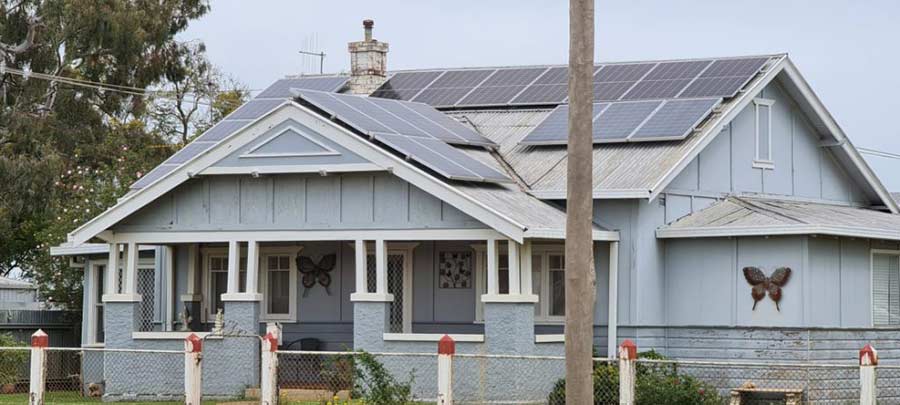
Clamp zones are for wusses, it’s wattage for winners.
Ground Mount Excellence.
Here’s a textbook use of a ground mount to avoid defacing an otherwise beautiful building. We don’t celebrate rusty sheds and industrial heritage nearly half as much as we should.
Filling The Roof Well
Thoughtful solar panel placement, maximum wattage using landscape and portrait orientation, and quality equipment.
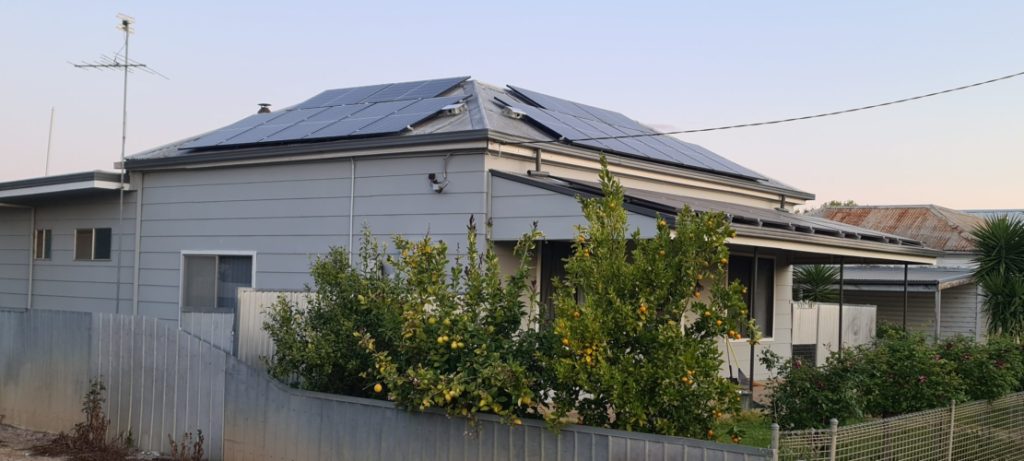
Even the verandah got a guernsey.
Spectacular Tilts
Across the street, things look decidedly ordinary in terms of angle frames constructed outside of manufacturer specifications, but I guess the proof is in the pudding. It hasn’t blown off and appears old enough that there must have been some weather to test it.
This reverse-pitch tilt frame results in a pretty flat array.
This particular bit of class shows a classic trap for solar installers. When buildings are extended, they often have different purlin spacings/screw lines. If you don’t notice and start building the solar frame, you can rapidly find there’s nothing to screw your solar onto halfway along the building. Exhibit one is the differently angled legs, a great reason for adjustable framing.
Roadtripping And EVs
Having spent 4 days covering 2,400km driving Adelaide-Dubbo return in a PHEV, I can see the point the naysayers have about electric vehicles and refuelling in 5 minutes. Charging stations certainly weren’t obvious enroute and towing an old car on a trailer wouldn’t be kind on battery life in a full EV.
However, it’s well known that lowering your speed from 110 to 90km/h can potentially double the range of an EV. The boomers towing behemoth caravans have already worked out that the simplest way to save money is to slow down, and lie to your friends about fuel mileage. These new BlandCruisers use half the fuel they tell me.
Road safety campaigns are all asking that we stop, revive, survive. Even my car posts little reminders to pull over every couple of hours, so being forced to stop for charging isn’t actually a bad thing. It’s not a new feature mind you; my early seventies Falcon with 20 litres/100km of pushrod simplicity and V8 thirst combined with a thimble-sized fuel tank means you are forced to take regular fuelling breaks.
I think EVs might be good for local communities. All the little dot towns with closed servos just need some investment in amenities and a fat grid connection. Most of them already seem to have good coffee and little museums.
I can only surmise those who carp and wail the loudest about not being able to go 1,000km non-stop do not actually like travelling, can’t stand their kids, and want it to be over before they ask again, “are we there yet?”.
Actually, we aren’t there yet, the energy transition is just getting its socks on.

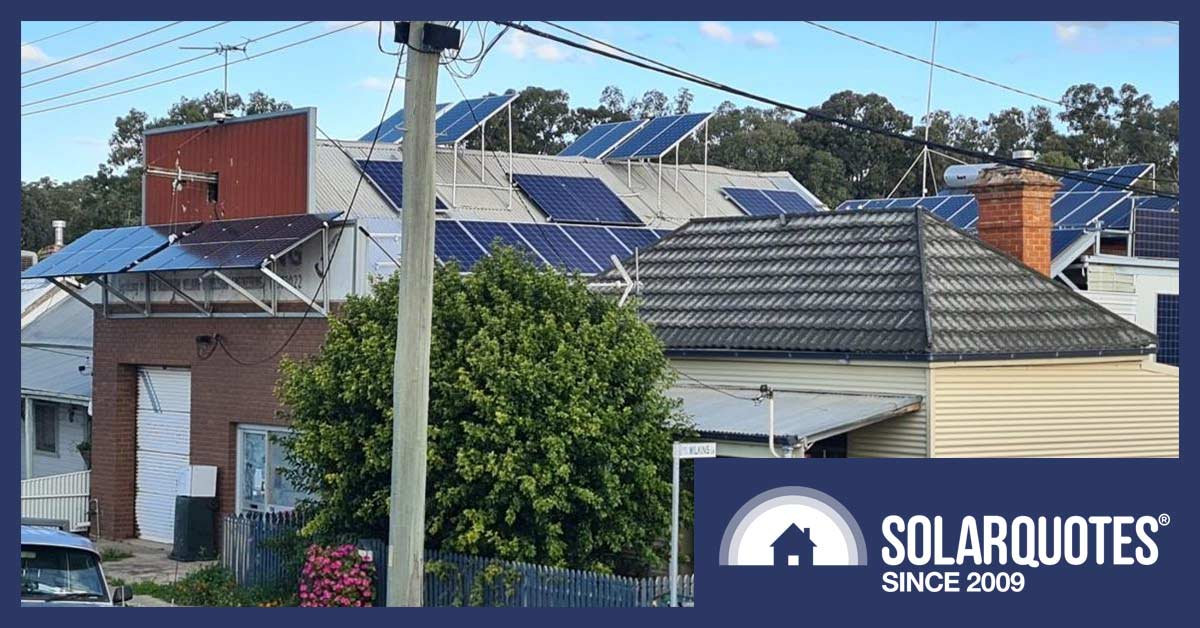
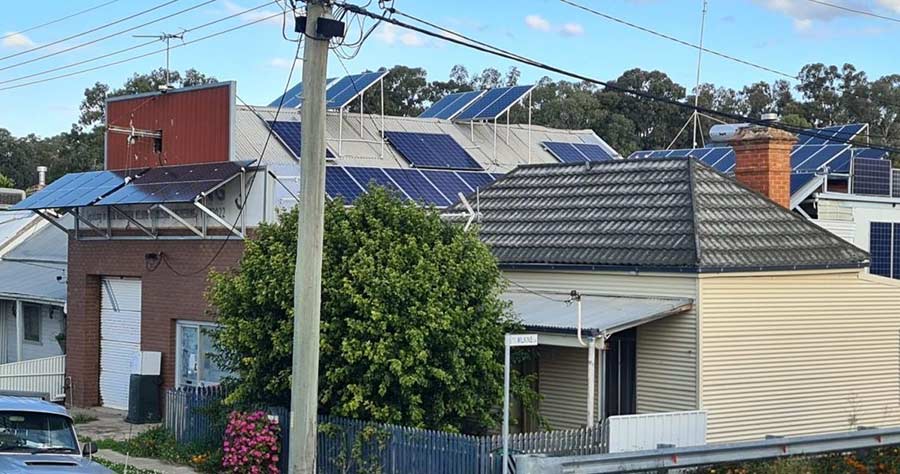
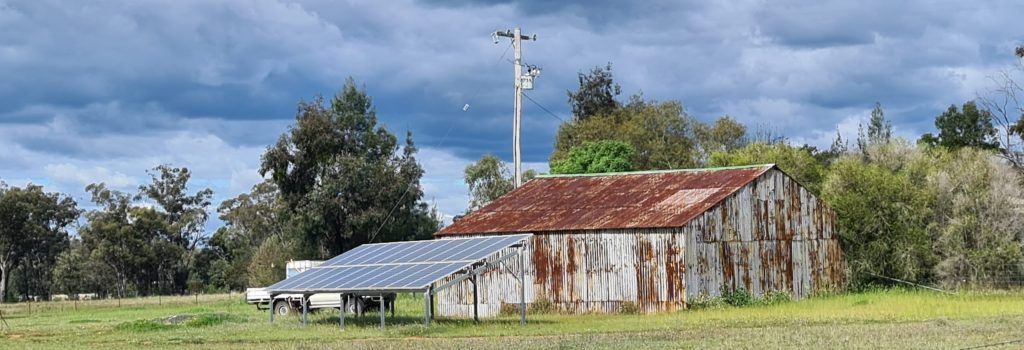
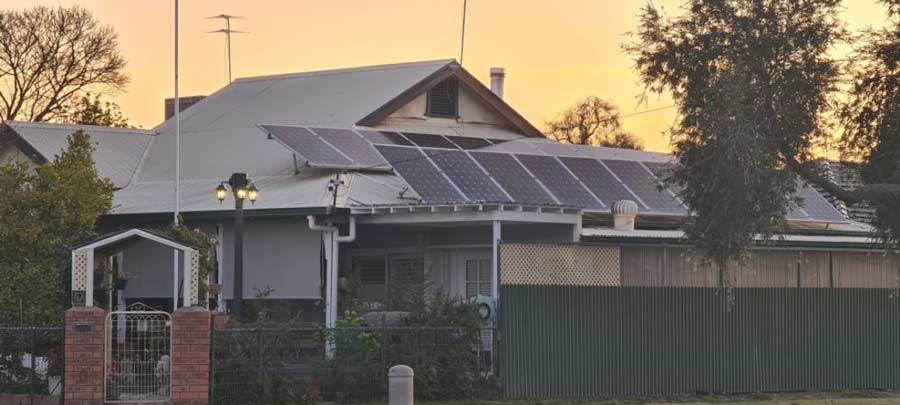
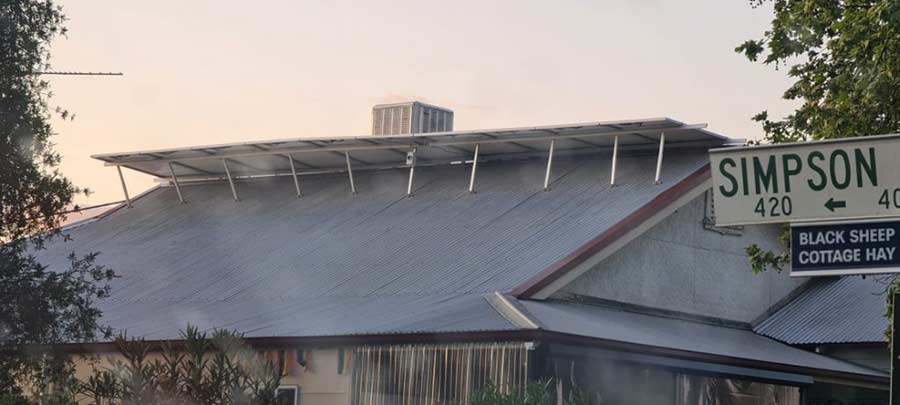
 RSS - Posts
RSS - Posts



I can see travel brochures “You gotta make Hay when the sun shines!”
LOL
Don’t come to my place
1st array (2000 ish) of BP80W, 2nd array of BP 130W ((2008) on my asbestos roof. Little concern back then
Third array on the carport (with shading issues grrrr) off grid boosting for the solar HWS. And about to put 2 more arrays on my rusty shed to charge an off grid battery which is currently getting a trickle from a solitary 290W panel
It ain’t pretty but it works
Getting my rusty roof replaced will probably cost more than a ground mount but shade isseus mean I have little choice
As I mentioned in a previous Blog, I recently completed a second big tour with a Volvo XC60 PHEV and small (1.5t) caravan covering Queensland, NSW & South Australia (well also a corner of Victoria – Mildura). Actually today’s flood maps of NSW more or less cover the towns we went through. So far we have travelled about 12,000km with the caravan.
Anyway, I certainly could not have done the trips with a pure EV due to the lack of charging facilities and the reduced range when towing. Also the mostly flat roads out west meant not much advantage from regenerative braking.
Without a caravan or roof pod the car predicts around 800km range on a full tank of petriol and 35km on a full battery (~10kWh capacity).
When towing at 100k/h the petrol range drops to about 350km (~16L/100km) and the electric range maybe 15km so topping up petrol at most large towns is wise when towing.
The Volvo has a feature where the battery can be charged from the petrol engine and sometimes when I am approaching a town I charge the battery to give me that extra range once the petrol tank if full. When towing, I like to keep the battery on hold at half capacity so I can engage the electric drive for long/steep ascents and ease the load on the petrol engine (it still has plenty of power for towing).
At powered caravan sites I like to charge the battery from a 240V outlet, if acceptable to the owners. This is also good for driving around the town on pure electric.
The other thing relevant to Anthony’s article is that many of the caravan parks that we stayed at had workers in cabins and caravans who were working on solar or wind farm installations.
I’m glad to see others are also covering the North East, North and North West to catch as much of the rays as possible. It only requires 3 separate strings. I’ve been doing that off grid for 15 yrs, now on my second set of AGMs and a Victron.
I wonder if government subsidies should start to encourage East and West facing panels specifically in some way. I’m not an expert but something I previously read suggested that panels East and West orientated panels can create significant amounts of energy during morning and evening peak demand.
Of course north would still likely come out ahead as better over either in the overall cost-benefit calculations of an individual roof owner and many would see little reason to add further East and West panels even if technically possible. What I’m getting at is the value of creating more renewable electricity for the grid at these peak times in future rather than deriving it from storage, with associated costs.
There’s some ‘installation art’ there for sure.
Perhaps coming electricity price peaks will encourage more people to try to capture every possible ray.
I’m wondering if some of these ideas should also go mainstream. For instance, with tasteful rack designs, maybe solar awnings could be incorporated into apartment designs and double as window shade.
And many apartment blocks (like mine) have underused grounds perfect for ground mounts with other functions. Our apartment garden has enough space for a pavilion that could fit a 10kW system on an unshaded roof. The block over the road has front gardens adjoining the drive big enough for a 20-30kW solar parking canopy, and they could put shared EV charging in.
My imagination is piqued now. I’m designing our ‘solar fence’ in my mind as we speak…
Clamp zones are for wusses, it’s wattage for winners
Brilliant
Just my thoughts.
If the $100million SA big battery paid for itself in 1 year trading energy on the national grid.
Could a country town big battery pay for itself in one year ????
Could an EV plugged into the national grid for one year, 24/7/365, pay for itself????
Lets not get too complicated on this.
Lets say 23 / 7 / 365 and 2 years.
That way you get to do your daily drive.
Hahaha, you do see what I mean.
Big batteries are valuable for the grid in these early days of transition to a full electric continent, the sunniest continent on the planet.
Rapid charging on long drives, on the few times most of us do that, would be easier if these big batteries are spread out every where.
Every town say.
That big battery did not pay for itself by selling power. It paid fir itself by supplying grid stabilisation and back up services. These services are not something a individual smaller battery can achieve in a standalone set-up. Sure there are battery aggregation promoters but at present they seem to make money at the expense of the battery owner.
The installation art (& awning) was on an engineering company, according to the sign.
I can only assume an idle engineer was showing off their abilities with that metalwork!
So I chose my installer in 2009 based on their reaction to the fact that I wanted to build the frame for the panels myself and turn the 6 panels into the roof over my chook food bins. Most told me no. They said I had no say in panel location as they were the experts. In the end an old solar business from Melbourne put in a system for me and another for my sister on the same day. The note on my switch board says “solar array on chook shed”. It hasn’t ever had a problem. In summer when the sun shines on the back of the panels the inverter turns back on for a short while just before the sun sets. I don’t think much power is generated but I have always wondered if panels could be double sided and installed vertically with faces east and west?